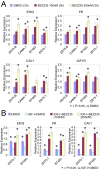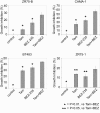Proteomic and transcriptomic profiling reveals a link between the PI3K pathway and lower estrogen-receptor (ER) levels and activity in ER+ breast cancer
- PMID: 20569503
- PMCID: PMC2917035
- DOI: 10.1186/bcr2594
Proteomic and transcriptomic profiling reveals a link between the PI3K pathway and lower estrogen-receptor (ER) levels and activity in ER+ breast cancer
Abstract
Introduction: Accumulating evidence suggests that both levels and activity of the estrogen receptor (ER) and the progesterone receptor (PR) are dramatically influenced by growth-factor receptor (GFR) signaling pathways, and that this crosstalk is a major determinant of both breast cancer progression and response to therapy. The phosphatidylinositol 3-kinase (PI3K) pathway, a key mediator of GFR signaling, is one of the most altered pathways in breast cancer. We thus examined whether deregulated PI3K signaling in luminal ER+ breast tumors is associated with ER level and activity and intrinsic molecular subtype.
Methods: We defined two independent molecular signatures of the PI3K pathway: a proteomic (reverse-phase proteomic array) PI3K signature, based on protein measurement for PI3K signaling intermediates, and a PI3K transcriptional (mRNA) signature based on the set of genes either induced or repressed by PI3K inhibitors. By using these signatures, we scored each ER+ breast tumor represented in multiple independent expression-profiling datasets (four mRNA, n = 915; one protein, n = 429) for activation of the PI3K pathway. Effects of PI3K inhibitor BEZ-235 on ER expression and activity levels and cell growth were tested by quantitative real-time PCR and cell proliferation assays.
Results: Within ER+ tumors, ER levels were negatively correlated with the PI3K activation scores, both at the proteomic and transcriptional levels, in all datasets examined. PI3K signature scores were also higher in ER+ tumors and cell lines of the more aggressive luminal B molecular subtype versus those of the less aggressive luminal A subtype. Notably, BEZ-235 treatment in four different ER+ cell lines increased expression of ER and ER target genes including PR, and treatment with IGF-I (which signals via PI3K) decreased expression of ER and target genes, thus further establishing an inverse functional relation between ER and PI3K. BEZ-235 had an additional effect on tamoxifen in inhibiting the growth of a number of ER+ cell lines.
Conclusions: Our data suggest that luminal B tumors have hyperactive GFR/PI3K signaling associated with lower ER levels, which has been correlated with resistance to endocrine therapy. Targeting PI3K in these tumors might reverse loss of ER expression and signaling and restore hormonal sensitivity.
Figures





Comment in
-
PI3K-based molecular signatures link high PI3K pathway activity with low ER levels in ER+ breast cancer.Expert Rev Proteomics. 2010 Dec;7(6):819-21. doi: 10.1586/epr.10.103. Expert Rev Proteomics. 2010. PMID: 21142884
References
-
- Bardou V-J, Arpino G, Elledge RM, Osborne CK, Clark GM. Progesterone receptor status significantly improves outcome prediction over estrogen receptor status alone for adjuvant endocrine therapy in two large breast cancer databases. J Clin Oncol. 2003;21:1973–1979. doi: 10.1200/JCO.2003.09.099. - DOI - PubMed
Publication types
MeSH terms
Substances
Grants and funding
LinkOut - more resources
Full Text Sources
Other Literature Sources
Medical
Research Materials

